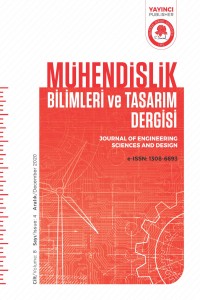Öz
Ardgemeli beton teknolojisi, günümüz şartlarında, endüstriyel alanda sıkça kullanılan bir sistem haline gelmiştir. Özellikle, köprü üstyapı sistemlerinde, betonun sahip olduğu yüksek basınç mukavemetinden faydalanarak, çelik donatı ve halatlar yardımıyla betonun çekme gerilmeleri zaafını kapatmayı amaçlar. Bu çalışmada, köprü üstyapısı, sonlu elemanlar yöntemi metodu kullanan bilgisayar yazılımı ile modellenmiştir. Üstyapı tasarımlarına; daimi yükler, geçici yükler ve zamana bağlı yükler uygulanmıştır. Kesit gerilmelerini dengelemek amacıyla, öngerme halatları analiz modellerine yerleştirilmiştir. Seçilen halat düzeninin tasarıma etkileri kıyaslanmıştır. Sonuç olarak, “en uygun” tasarıma ulaşmak adına halat kullanımı konusu detaylı bir şekilde incelenmiştir. Elde edilen bulgular, neden-sonuç ilişkisi kapsamında değerlendirilmiştir. Sonuçların yönlendirmiş olduğu iki ana bulgu; ardgermeli köprü tabliyelerinde kullanılan öngerme kablolarının kesit gerilmelerini takip eden parabolik bir yörünge izlemesinin ve mümkün olabildiğince daha büyük çaplı tüplerin içerisinden geçirilerek, kesit yüzeylerine yakınlaştırılmasının tesirleri karşılamak adına gereken toplam çelik halat metrajını düşüreceği saptanmıştır.
Anahtar Kelimeler
köprü betonarme ardgerme sonlu elemanlar yöntemi halat seçimleri
Kaynakça
- A. Ghallab, 2013, “Calculating ultimate tendon stress in externally prestressed continuous concrete beams using simplified formulas” Engineering Structures, 46, 417-430.
- American Association of State Highway and Transportation Officials. (2007). AASHTO guide specifications for LRFD seismic bridge design. Washington, DC.
- G. Ranzi and A. Ostinelli, 2017, “Ultimate behaviour and design of post-tensioned composite slabs” Engineering Structures, 150, 711-718.
- J. D. Chaitanya Kumar and L. Venkat, 2013, “Genetic algorithm based optimum design of prestressed concrete beam” International Journal of Civil and Structural Engineering, 3, 644–654.
- M. A. Pisani, 2018, “Behaviour under long-term loading of externally prestressed concrete beams” Engineering Structures, 160, 24-33.
- M. A. Utrilla and A. Samartin, 1991, “Optimized design of the prestress in continuous bridge decks” Computers and Structures, 1, 719-728.
- M. S. Kim, and Y. H. Lee, 2016, “Flexural behavior of posttensioned flat plates depending on tendon layout” Advances in Materials Science and Engineering, 1, 11.
- O. F. Hussien, T. H. K. Elafandy, A. A. Abdelrahman, S. A. Abdel Baky, and E. A. Nasr, 2012, “Behavior of bonded and unbonded prestressed normal and high strength concrete beams” HBRC Journal, vol. 8, 239–251.
- P. Fanning, 2001, “Nonlinear models of reinforced and posttensioned concrete beams” Electronic Journal of Structural Engineering, 2, 111–119.
- W. Marks, W. Trochymiak 1991, “The selection of a system of prestressing tendons in hyperstatic beams as a problem of linear integer programming” Structural and Multidisciplinary Optimization, vol. 3, 59-67.
Öz
In recent years, post-tensioned concrete technology has become widely used one in bridge engineering. Post tensioning system aims to use the high compressive strength of concrete and helps to resist on tension stresses with tendons and reinforcements. The aim of this paper is to study on finite element analysis of two-span post-tensioned concrete bridge decks and tendon usage. Bridge is 2-span and superstructure type is voided slab. Permanent, transient and time-dependent loading types were considered. To balance the deck section stresses, prestressing tendons were used. By iterations, post-tensioned tendons layout and types were studied. Two main results have been found that a parabolic trajectory tracing following sectional stresses of prestressing cables used in post-tensioned bridge decks and passing them through tubes of larger diameter as possible will decrease the required amount of tendon usage.
Anahtar Kelimeler
Bridge Concrete Post-Tensioned Finite Element Analysis Tendon Usage
Kaynakça
- A. Ghallab, 2013, “Calculating ultimate tendon stress in externally prestressed continuous concrete beams using simplified formulas” Engineering Structures, 46, 417-430.
- American Association of State Highway and Transportation Officials. (2007). AASHTO guide specifications for LRFD seismic bridge design. Washington, DC.
- G. Ranzi and A. Ostinelli, 2017, “Ultimate behaviour and design of post-tensioned composite slabs” Engineering Structures, 150, 711-718.
- J. D. Chaitanya Kumar and L. Venkat, 2013, “Genetic algorithm based optimum design of prestressed concrete beam” International Journal of Civil and Structural Engineering, 3, 644–654.
- M. A. Pisani, 2018, “Behaviour under long-term loading of externally prestressed concrete beams” Engineering Structures, 160, 24-33.
- M. A. Utrilla and A. Samartin, 1991, “Optimized design of the prestress in continuous bridge decks” Computers and Structures, 1, 719-728.
- M. S. Kim, and Y. H. Lee, 2016, “Flexural behavior of posttensioned flat plates depending on tendon layout” Advances in Materials Science and Engineering, 1, 11.
- O. F. Hussien, T. H. K. Elafandy, A. A. Abdelrahman, S. A. Abdel Baky, and E. A. Nasr, 2012, “Behavior of bonded and unbonded prestressed normal and high strength concrete beams” HBRC Journal, vol. 8, 239–251.
- P. Fanning, 2001, “Nonlinear models of reinforced and posttensioned concrete beams” Electronic Journal of Structural Engineering, 2, 111–119.
- W. Marks, W. Trochymiak 1991, “The selection of a system of prestressing tendons in hyperstatic beams as a problem of linear integer programming” Structural and Multidisciplinary Optimization, vol. 3, 59-67.
Ayrıntılar
| Birincil Dil | Türkçe |
|---|---|
| Konular | İnşaat Mühendisliği |
| Bölüm | Araştırma Makaleleri \ Research Articles |
| Yazarlar | |
| Yayımlanma Tarihi | 25 Aralık 2020 |
| Gönderilme Tarihi | 14 Nisan 2019 |
| Kabul Tarihi | 21 Eylül 2020 |
| Yayımlandığı Sayı | Yıl 2020 Cilt: 8 Sayı: 4 |


